Related Research Articles

A bicycle, also called a bike or cycle, is a human-powered or motor-powered, pedal-driven, single-track vehicle, having two wheels attached to a frame, one behind the other. A bicycle rider is called a cyclist, or bicyclist.
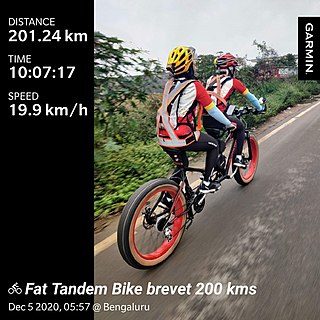
The tandem bicycle or twin is a form of bicycle designed to be ridden by more than one person. The term tandem refers to the seating arrangement, not the number of riders. Patents related to tandem bicycles date from the mid 1880s. Tandems can reach higher speeds than the same riders on single bicycles, and tandem bicycle racing exists. As with bicycles for single riders, there are many variations that have been developed over the years.

A recumbent bicycle is a bicycle that places the rider in a laid-back reclining position. Most recumbent riders choose this type of design for ergonomic reasons: the rider's weight is distributed comfortably over a larger area, supported by back and buttocks. On a traditional upright bicycle, the body weight rests entirely on a small portion of the sitting bones, the feet, and the hands.
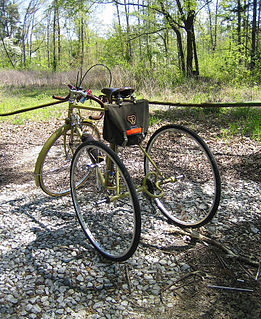
A tricycle, often abbreviated to trike, is a human-powered three-wheeled vehicle.

A velomobile, velomobiel, velo, or bicycle car is a human-powered vehicle (HPV) enclosed for aerodynamic advantage and/or protection from weather and collisions. They are similar to recumbent bicycles, pedal go-karts and tricycles, but with a full fairing. A fairing may be added to a non-faired cycle, or the fairing may be an integral part of the structure, monocoque like that of an airplane. The term velomobile can be thought of as similar in scope to the cycle world as the term automobile is to the automotive world.

The bottom bracket on a bicycle connects the crankset (chainset) to the bicycle and allows the crankset to rotate freely. It contains a spindle to which the crankset attaches, and the bearings that allow the spindle and cranks to rotate. The chainrings and pedals attach to the cranks. Bottom bracket bearings fit inside the bottom bracket shell, which connects the seat tube, down tube and chain stays as part of the bicycle frame.
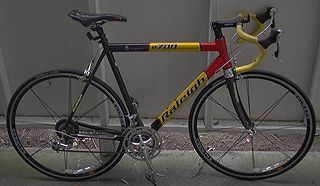
A racing bicycle, also known as a road bike, and once popularly known as a ten speed, is a bicycle designed for competitive road cycling, a sport governed by and according to the rules of the Union Cycliste Internationale (UCI). The UCI rules were altered in 1934 to exclude recumbent bicycles.
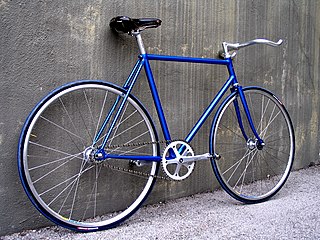
A fixed-gear bicycle is a bicycle that has a drivetrain with no freewheel mechanism. The freewheel was developed early in the history of bicycle design but the fixed-gear bicycle remained the standard track racing design. More recently the "fixie" has become a popular alternative among mainly urban cyclists, offering the advantage of simplicity compared with the standard multi-geared bicycle.

This is a glossary of terms and jargon used in cycling, mountain biking, and cycle sport.
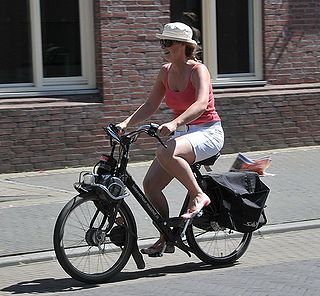
A motorized bicycle is a bicycle with an attached motor or engine and transmission used either to power the vehicle unassisted, or to assist with pedalling. Since it always retains both pedals and a discrete connected drive for rider-powered propulsion, the motorized bicycle is in technical terms a true bicycle, albeit a power-assisted one. However, for purposes of governmental licensing and registration requirements, the type may be legally defined as a motor vehicle, motorbike, moped, or a separate class of hybrid vehicle.

An electric bicycle also known as an e-bike or ebike is a bicycle with an integrated electric motor which can be used to assist propulsion. Many kinds of e-bikes are available worldwide, but generally fall into two broad categories. Bikes that assist the rider's pedal-power and bikes that add a throttle, integrating moped-style functionality. Both retain the ability to be pedaled by the rider and are therefore not electric motorcycles.

A belt-driven bicycle is a chainless bicycle that uses a toothed synchronous belt to transmit power from the pedals to the wheel.
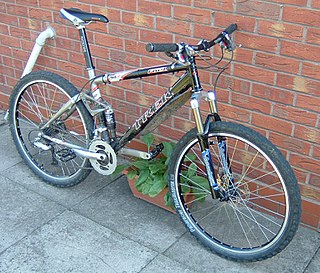
Bicycle suspension is the system, or systems, used to suspend the rider and bicycle in order to insulate them from the roughness of the terrain. Bicycle suspension is used primarily on mountain bikes, but is also common on hybrid bicycles.
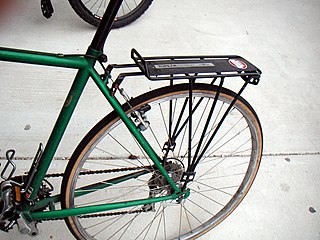
A luggage carrier, also commonly called a rack, is a device attached to a bicycle to which cargo or panniers can be attached. This is popular with utility bicycles and touring bicycles.
Barbara Buatois is a French racing cyclist and one of the fastest female recumbent racers and ultra cyclists.

The following outline is provided as an overview of and topical guide to bicycles:
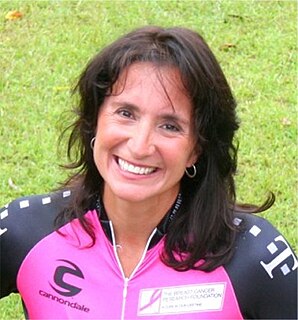
Maria Parker is an American long-distance cyclist and the holder of multiple cycling records. She is also the founder of 3000 Miles to a Cure, an organization to raise money for Accelerate Brain Cancer Cure.
The hour record is the record for the longest distance cycled in one hour on a bicycle from a stationary start. Cyclists attempt this record alone on the track without other competitors present. It is considered perhaps the most prestigious record in all of cycling. Over history, various cyclists ranging from unknown amateurs to well-known professionals have held the record, adding to its prestige and allure. There are several records, one of which is the record for streamlined human powered vehicles, also known as recumbent bicycles.
Lightning is a brand of recumbent bicycles produced by Lightning Cycle Dynamics based in Lompoc, California, United States. In 1979 the first Lightning recumbent was built by three students from Northrop Institute of Technology - Tim Brummer, Don Guichard and Chris Dreike. In 1981 Brummer won the Abbott prize in a Lightning recumbent for the first human-powered vehicle to break the then-common speed limit of 55 mph. A four-man team set the fastest time for the 1989 Race Across America, a record that still stands. They have also won the STP Challenge, among other achievements. Today Lightning Cycle Dynamics produces recumbent bicycles and carbon cranks. Many of the bikes are made in the U.S.
References
- ↑ "CRUZBIKE−invented by John Tolhurst". ABC New Inventors. Retrieved 22 February 2016.
- ↑ "Quest review". Bentrider online. Retrieved 25 October 2015.
- ↑ "Conversion kit history". Cruzbiking AU. Retrieved 25 October 2015.
- ↑ (A1) USapplication 2006226630 (A1),John Irven Tolhurst,"Assembly for converting standard bicycle into a recumbent and a bicycle incorporating the assembly",published 2006/10/12
- ↑ USpatent 7753388,John Irven Tolhurst,"Front Wheel Drive Recumbent Bicycle",issued 2010/07/13
- ↑ "Changes at Cruzbike". Cruzbike. Retrieved 25 October 2015.
- ↑ "Woman Attempts 12-hour World Record on New Front-Wheel-Drive Recumbent Bicycle". PRWEB. Retrieved 22 February 2016.
- ↑ "Cruzbike records". Cruzbike. Retrieved 22 February 2016.
- ↑ "WRRA records". World Recumbent Racing Association. Retrieved 6 April 2016.
- ↑ "RAAM 2013 - A year of records and inspiration". bikemag. Retrieved 23 February 2016.
- ↑ "UMCA WA N-S record". Archived from the original on 2017-04-05. Retrieved 2017-04-05.
- ↑ "WRRA records". World Recumbent Racing Association. Retrieved 6 April 2016.
- ↑ "Bike Sebring race results, 2016, 12-hour". Bike Sebring. Retrieved 6 April 2016.
- ↑ https://cruzbike.com/products/q45
- ↑ https://cruzbike.com/products/t50
- ↑ https://cruzbike.com/products/t50e
- ↑ https://cruzbike.com/products/s40
- ↑ https://cruzbike.com/products/v20